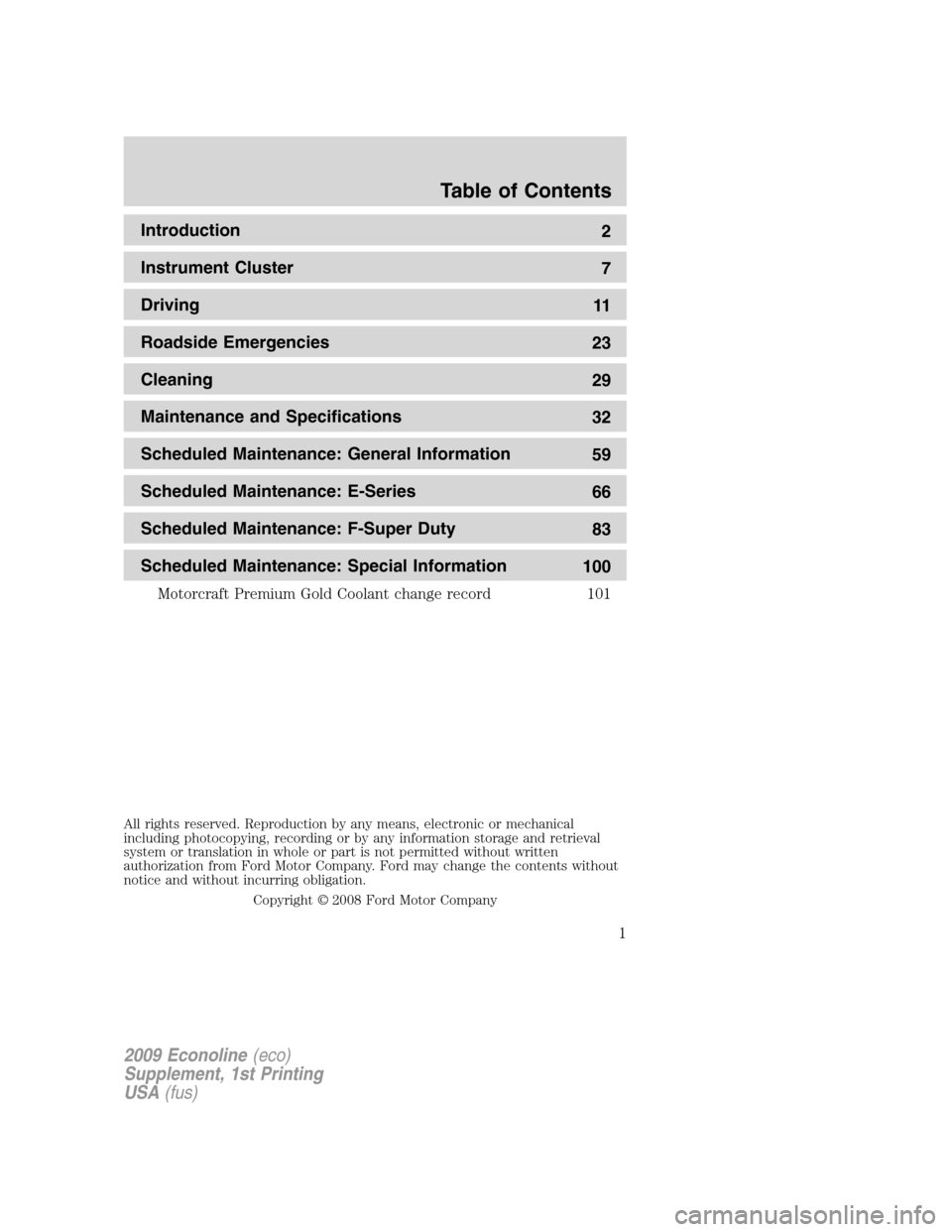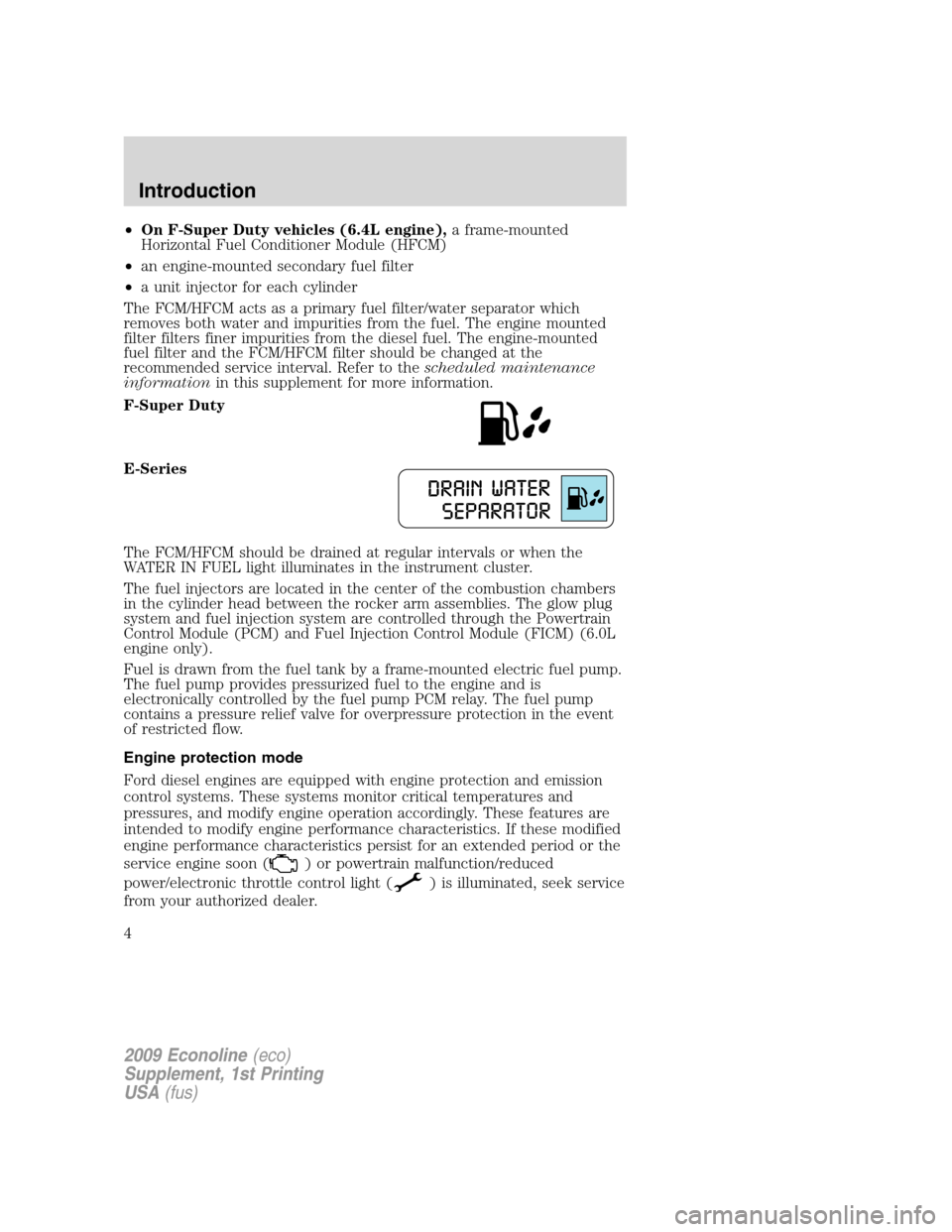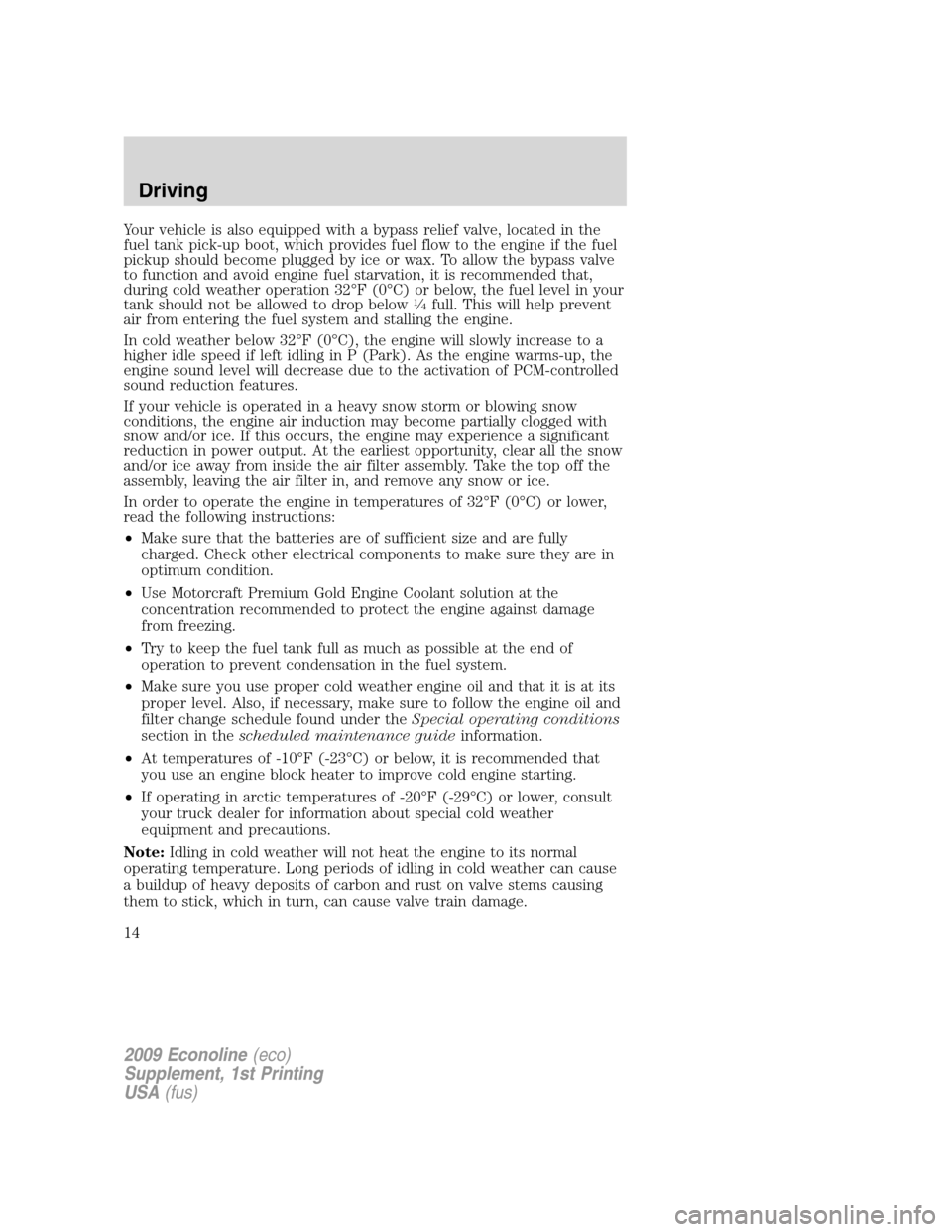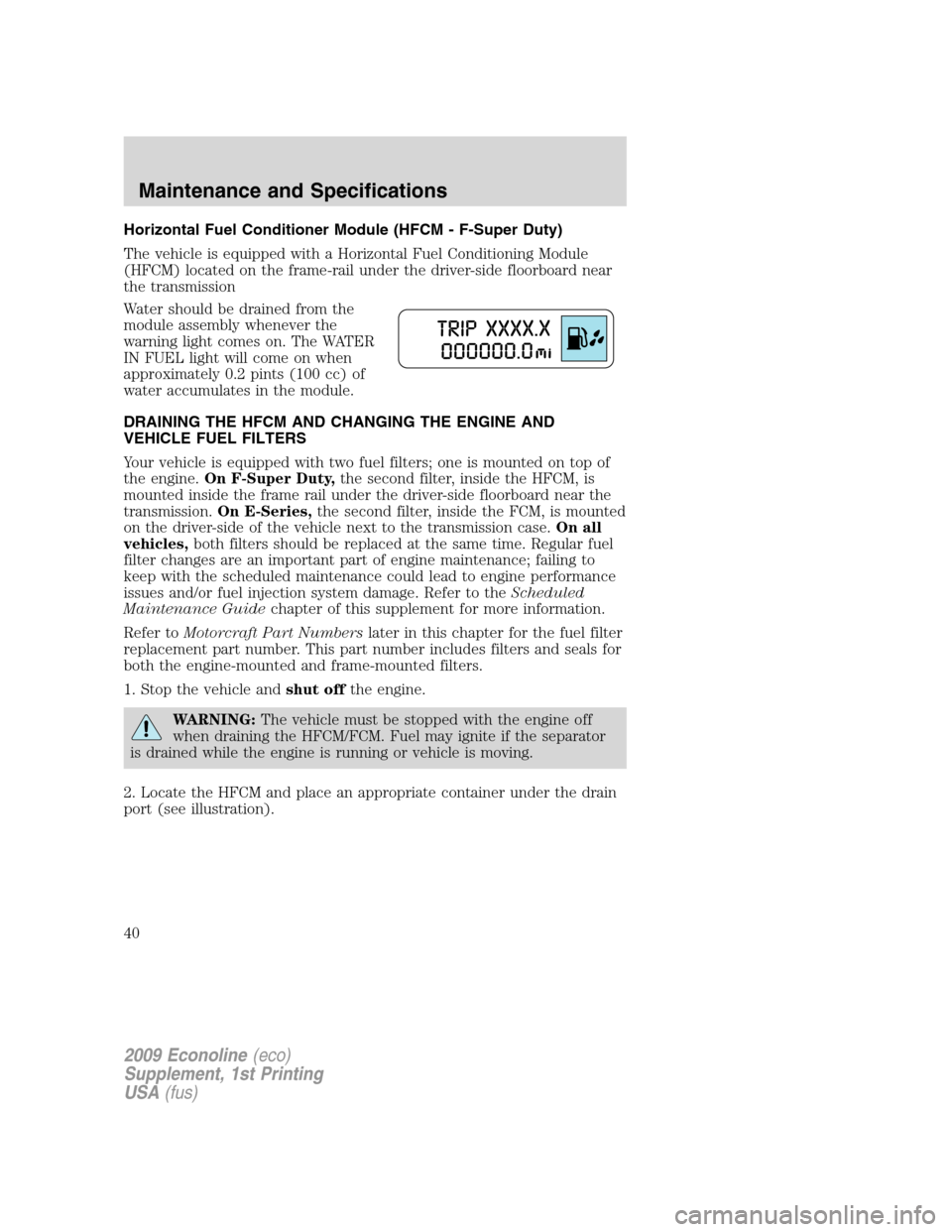2009 FORD SUPER DUTY maintenance schedule
[x] Cancel search: maintenance schedulePage 1 of 103

Introduction
2
Instrument Cluster
7
Driving
11
Roadside Emergencies
23
Cleaning
29
Maintenance and Specifications
32
Scheduled Maintenance: General Information
59
Scheduled Maintenance: E-Series
66
Scheduled Maintenance: F-Super Duty
83
Scheduled Maintenance: Special Information
100
Motorcraft Premium Gold Coolant change record 101
All rights reserved. Reproduction by any means, electronic or mechanical
including photocopying, recording or by any information storage and retrieval
system or translation in whole or part is not permitted without written
authorization from Ford Motor Company. Ford may change the contents without
notice and without incurring obligation.
Copyright © 2008 Ford Motor Company
Table of Contents
1
2009 Econoline(eco)
Supplement, 1st Printing
USA(fus)
Page 4 of 103

•On F-Super Duty vehicles (6.4L engine),a frame-mounted
Horizontal Fuel Conditioner Module (HFCM)
•an engine-mounted secondary fuel filter
•a unit injector for each cylinder
The FCM/HFCM acts as a primary fuel filter/water separator which
removes both water and impurities from the fuel. The engine mounted
filter filters finer impurities from the diesel fuel. The engine-mounted
fuel filter and the FCM/HFCM filter should be changed at the
recommended service interval. Refer to thescheduled maintenance
informationin this supplement for more information.
F-Super Duty
E-Series
The FCM/HFCM should be drained at regular intervals or when the
WATER IN FUEL light illuminates in the instrument cluster.
The fuel injectors are located in the center of the combustion chambers
in the cylinder head between the rocker arm assemblies. The glow plug
system and fuel injection system are controlled through the Powertrain
Control Module (PCM) and Fuel Injection Control Module (FICM) (6.0L
engine only).
Fuel is drawn from the fuel tank by a frame-mounted electric fuel pump.
The fuel pump provides pressurized fuel to the engine and is
electronically controlled by the fuel pump PCM relay. The fuel pump
contains a pressure relief valve for overpressure protection in the event
of restricted flow.
Engine protection mode
Ford diesel engines are equipped with engine protection and emission
control systems. These systems monitor critical temperatures and
pressures, and modify engine operation accordingly. These features are
intended to modify engine performance characteristics. If these modified
engine performance characteristics persist for an extended period or the
service engine soon (
) or powertrain malfunction/reduced
power/electronic throttle control light (
) is illuminated, seek service
from your authorized dealer.
2009 Econoline(eco)
Supplement, 1st Printing
USA(fus)
Introduction
4
Page 14 of 103

Your vehicle is also equipped with a bypass relief valve, located in the
fuel tank pick-up boot, which provides fuel flow to the engine if the fuel
pickup should become plugged by ice or wax. To allow the bypass valve
to function and avoid engine fuel starvation, it is recommended that,
during cold weather operation 32°F (0°C) or below, the fuel level in your
tank should not be allowed to drop below
1�4full. This will help prevent
air from entering the fuel system and stalling the engine.
In cold weather below 32°F (0°C), the engine will slowly increase to a
higher idle speed if left idling in P (Park). As the engine warms-up, the
engine sound level will decrease due to the activation of PCM-controlled
sound reduction features.
If your vehicle is operated in a heavy snow storm or blowing snow
conditions, the engine air induction may become partially clogged with
snow and/or ice. If this occurs, the engine may experience a significant
reduction in power output. At the earliest opportunity, clear all the snow
and/or ice away from inside the air filter assembly. Take the top off the
assembly, leaving the air filter in, and remove any snow or ice.
In order to operate the engine in temperatures of 32°F (0°C) or lower,
read the following instructions:
•Make sure that the batteries are of sufficient size and are fully
charged. Check other electrical components to make sure they are in
optimum condition.
•Use Motorcraft Premium Gold Engine Coolant solution at the
concentration recommended to protect the engine against damage
from freezing.
•Try to keep the fuel tank full as much as possible at the end of
operation to prevent condensation in the fuel system.
•Make sure you use proper cold weather engine oil and that it is at its
proper level. Also, if necessary, make sure to follow the engine oil and
filter change schedule found under theSpecial operating conditions
section in thescheduled maintenance guideinformation.
•At temperatures of -10°F (-23°C) or below, it is recommended that
you use an engine block heater to improve cold engine starting.
•If operating in arctic temperatures of -20°F (-29°C) or lower, consult
your truck dealer for information about special cold weather
equipment and precautions.
Note:Idling in cold weather will not heat the engine to its normal
operating temperature. Long periods of idling in cold weather can cause
a buildup of heavy deposits of carbon and rust on valve stems causing
them to stick, which in turn, can cause valve train damage.
2009 Econoline(eco)
Supplement, 1st Printing
USA(fus)
Driving
14
Page 34 of 103

The horizontal fuel conditioner module (HFCM) is located on the
frame-rail under the driver-side floorboard near the transmission.
SCHEDULED MAINTENANCE
The scheduled maintenance services in thescheduled maintenance
informationof this supplement are required because they are
considered essential to the life and performance of your vehicle.
Use only recommended fuel, lubricants, fluids and service parts
conforming to Ford specifications. Motorcraft parts are designed and
built for best performance in your vehicle.
FUEL REQUIREMENTS - CHOOSING THE RIGHT FUEL: VEHICLES
OPERATED WHERE ULTRA LOW SULFUR DIESEL FUEL IS
REQUIRED (UNITED STATES/CANADA/PUERTO RICO/U.S. VIRGIN
ISLANDS AND OTHER LOCALES)
Use only Ultra Low Sulfur (15 ppm Sulfur Maximum) number 1-D
or 2-D diesel fuel (also known as ULSD) in your 6.4L diesel
engine.The engine and exhaust system were designed to only use this
fuel. Look for theULTRA-LOW SULFUR HIGHWAY DIESEL FUEL
(15 ppm Sulfur Maximum)label on fuel pumps when purchasing your
fuel.
Using low sulfur diesel fuel (16-500 ppm) or high sulfur diesel
fuel (greater than 500 ppm) in a 6.4L diesel engine designed to
use only Ultra Low Sulfur Diesel fuel will cause certain emission
components to malfunction which may also cause the Service
Engine Soon(
)light to illuminate indicating an
emissions-related concern.
Number 1-D or winter blend number 2-D fuel is recommended at
temperatures below 20°F (-7°C) (seeCold weather operationin the
Drivingchapter of this supplement).
2009 Econoline(eco)
Supplement, 1st Printing
USA(fus)
Maintenance and Specifications
34
Page 35 of 103

BIODIESEL
Diesel fuel containing no more than 5% biodiesel may be used. To help
achieve acceptable engine performance and durability, it is important to
only use biodiesel of good quality in your diesel engine. At a minimum,
the biodiesel should comply with ASTM D6751 or an equivalent
specification.
Use of biodiesel in concentrations greater than 5% may cause damage to
your vehicles fuel system components such as fuel tank, fuel lines, fuel
pump, fuel sender and fuel injectors. Concentrations greater than 5% can
also cause fuel filter restrictions that may result in a lack of power and
or fuel pump and fuel injector failure.
Look for a label on the fuel pump to confirm the amount of biodiesel
contained in a diesel fuel. Biodiesel content is often indicated with the
letter “B” followed by the percent of biodiesel in the fuel. For example,
B5 indicates a fuel containing 5% biodiesel. Ask the service station
attendant to confirm the biodiesel content of a diesel fuel if you do not
see a label on the fuel pump.
Biodiesel should not be stored in the fuel tank for more than three
months. If your vehicle will be parked or stored for more than three
months, then your vehicle should be drained and filled with a diesel fuel
not containing biodiesel.
During cold weather, if you have problems operating on biodiesel, you
may need to use a diesel fuel with lower biodiesel content, try another
brand, or discontinue the use of biodiesel.
Biodiesel use may affect the recommended oil change intervals. Refer to
theSpecial Operating Conditionssection in theschedule
maintenance guidefor more information about oil change intervals and
other maintenance when operating on biodiesel.
Biodiesel fuel is a product that has been converted from renewable fuel
sources, including vegetable oil, animal fat and cooking oil. Raw or
refined vegetable oil, animal fat, cooking oil or recycled greases should
not be used.
Do not use home heating oil, agricultural fuel or any diesel fuel
not intended for highway use. Damage to the fuel injection
system, engine and exhaust catalyst can occur if an improper fuel
is used. Do not add gasoline, gasohol or alcohol to diesel fuel.
This practice creates a serious fire hazard and engine
performance problems.
2009 Econoline(eco)
Supplement, 1st Printing
USA(fus)
Maintenance and Specifications
35
Page 37 of 103

letter “B” followed by the percent of biodiesel in the fuel. For example,
B5 indicates a fuel containing 5% biodiesel. Ask the service station
attendant to confirm the biodiesel content of a diesel fuel if you do not
see a label on the fuel pump.
Biodiesel should not be stored in the fuel tank for more than three
months. If your vehicle will be parked or stored for more than three
months, then your vehicle should be drained and filled with a diesel fuel
not containing biodiesel.
During cold weather, if you have problems operating on biodiesel, you
may need to use a diesel fuel with lower biodiesel content, try another
brand, or discontinue the use of biodiesel.
Biodiesel use may affect the recommended oil change intervals. Refer to
theSpecial Operating Conditionssection in theschedule
maintenance guidefor more information about oil change intervals and
other maintenance when operating on biodiesel.
Biodiesel fuel is a product that has been converted from renewable fuel
sources, including vegetable oil, animal fat and cooking oil. Raw or
refined vegetable oil, animal fat, cooking oil or recycled greases should
not be used.
Do not use home heating oil, agricultural fuel or any diesel fuel
not intended for highway use. Damage to the fuel injection
system, engine and exhaust catalyst can occur if an improper fuel
is used. Do not add gasoline, gasohol or alcohol to diesel fuel.
This practice creates a serious fire hazard and engine
performance problems.
Fuel quality
It should not be necessary to add any aftermarket additives to your fuel
tank if you use a properly formulated diesel fuel that meets the ASTM D
975 industry specification. Aftermarket additives can damage the injector
system or engine. Repairs to correct the effects of using an aftermarket
product in your fuel may not be covered by your warranty.
Do not blend used engine oil with diesel fuel under any
circumstances.Blending used oil with the fuel will significantly increase
your vehicle’s exhaust emissions and reduce engine life due to increased
internal wear.
Many of the world’s automakers approved the World-wide Fuel Charter
that recommends diesel fuel specifications to provide improved
performance and emission control system protection for your vehicle.
Diesel fuel that meets the World-wide Fuel Charter should be used when
available. Ask your fuel supplier about fuel that meets the World-wide
Fuel Charter.
2009 Econoline(eco)
Supplement, 1st Printing
USA(fus)
Maintenance and Specifications
37
Page 40 of 103

Horizontal Fuel Conditioner Module (HFCM - F-Super Duty)
The vehicle is equipped with a Horizontal Fuel Conditioning Module
(HFCM) located on the frame-rail under the driver-side floorboard near
the transmission
Water should be drained from the
module assembly whenever the
warning light comes on. The WATER
IN FUEL light will come on when
approximately 0.2 pints (100 cc) of
water accumulates in the module.
DRAINING THE HFCM AND CHANGING THE ENGINE AND
VEHICLE FUEL FILTERS
Your vehicle is equipped with two fuel filters; one is mounted on top of
the engine.On F-Super Duty,the second filter, inside the HFCM, is
mounted inside the frame rail under the driver-side floorboard near the
transmission.On E-Series,the second filter, inside the FCM, is mounted
on the driver-side of the vehicle next to the transmission case.On all
vehicles,both filters should be replaced at the same time. Regular fuel
filter changes are an important part of engine maintenance; failing to
keep with the scheduled maintenance could lead to engine performance
issues and/or fuel injection system damage. Refer to theScheduled
Maintenance Guidechapter of this supplement for more information.
Refer toMotorcraft Part Numberslater in this chapter for the fuel filter
replacement part number. This part number includes filters and seals for
both the engine-mounted and frame-mounted filters.
1. Stop the vehicle andshut offthe engine.
WARNING:The vehicle must be stopped with the engine off
when draining the HFCM/FCM. Fuel may ignite if the separator
is drained while the engine is running or vehicle is moving.
2. Locate the HFCM and place an appropriate container under the drain
port (see illustration).
2009 Econoline(eco)
Supplement, 1st Printing
USA(fus)
Maintenance and Specifications
40
Page 47 of 103

Changing engine oil and filter
Change your oil and filter according to thescheduled maintenance
informationin this supplement. Change more frequently if your vehicle
operation includes extended periods of idling or low-speed operation,
driving for a long time in cold temperatures or driving short distances.
See the following sectionEngine lubrication for severe service
operationfor all severe duty restrictions.
Refer toMotorcraft Part Numberslater in this chapter for the engine oil
filter part number. This filter protects your engine by filtering harmful,
abrasive or sludge particles and particles significantly smaller than most
available “will-fit” filters.
To replace the filter,
1. Unscrew the oil filter cap and wait a few seconds for the oil to drain
through the built-in drain valve.Note:The filter should be changed
before reinstalling the oil pan drain plug.
2. Reinstall and tighten the oil filter cap.
WARNING:Do not handle a hot oil filter with bare hands.
WARNING:Continuous contact with USED motor oil has caused
cancer in laboratory mice. Protect your skin by washing with
soap and water.
Engine lubrication for severe service operation
The following severe service operating conditions require unique engine
maintenance procedures:
•frequent or extended idling (over 10 minutes per hour of normal
driving).
•if vehicle is operated in sustained ambient temperatures below -10°F
(-23°C) or above 100°F (38°C)
•frequent low speed operation, consistent heavy traffic less than
25 mph (40 km/h)
•operating in severe dust conditions.
•towing a trailer over 1,000 miles (1,600 km)
•sustained, high speed driving at Gross Vehicle Weight Rating
(maximum loaded weight for vehicle operation)
2009 Econoline(eco)
Supplement, 1st Printing
USA(fus)
Maintenance and Specifications
47